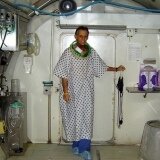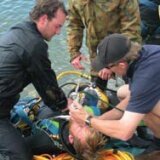Hyperbaric Oxygen And Hyperoxygenation

Hyperbaric oxygen is 100% pure oxygen used as a drug under increased atmospheric pressure maintained inside a sealed Hyperbaric Chamber.
Hyperoxygenation of body tissues is a major instrumental function of the Hyperbaric Oxygen Treatment.
The primary mechanism of Hyperbaric Medicine is governed by physical laws described by Charles, Boyle and Henry. These laws are also known as an ideal gas laws.
Summarizing interactions between gases, liquids, temperature and pressure, Henry law explains the physical reason for hyperbaric oxygenation: "The amount of any given gas that will dissolve in a liquid at a given temperature is directly proportional to the partial pressure of that gas."
If atmospheric pressure increased, more oxygen is dissolved into body fluids including blood, plasma, lymphatic fluid, cerebrospinal fluid, and interstitial fluid, than it would be seen under the normobaric pressure.
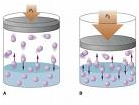
Oxygen Transport To Tissues And Normobaric Oxygenation
The life actually occurs at a cellular level. Oxygen element is the most essential element in biochemical and physiologic processes enabling vital aerobic cellular respiration.
Tissue oxygenation is a process which starts in the lungs alveoli and pulmonary capillary system where blood and plasma saturate with oxygen taken from the inspired air (see the respiratory system diagram).

Oxygen is transported from the air that we breathe to each cell in the body. In general, gases move from an area of high concentration (pressure) to areas of low concentration (pressure). If there are a mixture of gases in a container, the pressure of each gas (partial pressure) is equal to the pressure that each gas would produce if it occupied the container alone.
The air (atmosphere) around us has a total pressure of 760 mmHg (1 atmosphere of pressure = 760mmHg = 101kPa = 15lbs/sq. in). Air is made up of 21% oxygen, 78% nitrogen and small quantities of CO2, argon and helium. The pressure exerted by the main two gases individually, when added together, equals the total surrounding pressure or atmospheric pressure. The pressure of oxygen (PO2) of dry air at sea level is therefore 159 mmHg (21/100 x 760=159).
However by the time the inspired air reaches the trachea it has been warmed and humidified by the upper respiratory tract. The humidity is formed by water vapour which as a gas exerts a pressure. At 37oC the water vapour pressure in the trachea is 47 mmHg. Taking the water vapour pressure into account, the PO2 in the trachea when breathing air is (760-47) x 21/100 = 150 mmHg. By the time the oxygen has reached the alveoli the PO2 has fallen to about 100 mmHg. This is because the PO2 of the gas in the alveoli (PAO2) is a balance between two processes: the removal of oxygen by the pulmonary capillaries and its continual supply by alveolar ventilation (breathing)
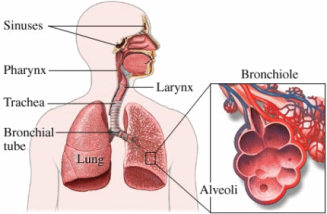
Haemoglobin Oxygen Binding
Oxygen is carried in the blood in two forms. Most is carried combined with haemoglobin, an amazing multi-task-performing molecule of blood. Haemoglobin molecules are carried in our bloodstream by red blood cells, erythrocytes. But there is a very small amount dissolved in the plasma. Each gram of haemoglobin can carry 1.31 ml of oxygen when it is fully saturated. Therefore every litre of blood with a Hb concentration of 15g/dl can carry about 200 mls of oxygen when fully saturated (occupied) with oxygen (PO2 >100 mmHg). At this PO2 only 3 ml of oxygen will dissolve in every litre of plasma.
Thus the arterial oxygen saturation (SaO2) is proportional to an individuals binding capacity of haemoglobin. SaO2 is usually measured by noninvasive method, pulse oximetry, but it can also be measured by testing arterial blood gas. Abnormal arterial oxygen saturation can lead to a tissue hypoxia.
Adequate tissue oxygenation under normobaric conditions, e.i. under a normal atmospheric pressure, indicates that a delivery rate of oxygen transported from the lungs to the peripheral tissues satisfies their metabolic requirements.
Oxygen consumption is a rate at which oxygen is dissolved from the blood and plasma for use by the tissues. Our body tissues at rest usually consume 5-6 mL of oxygen per deciliter of blood. The image below illustrates haemoglobin binding process.
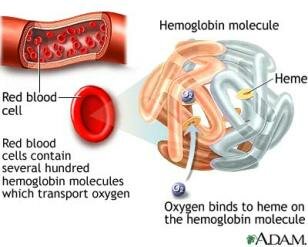
Again, there is a physiologic maximum restricting the blood's carrying capacity of oxygen to a certain extent: 1g of haemoglobin binds only up to 1.34 cm3 of oxygen. Illness or injury tends to compromise oxygen-carrying capacity of blood.
If the PO2 of oxygen in arterial blood (PAO2) is increased significantly (by breathing 100% oxygen) then a small amount of extra oxygen will dissolve in the plasma (at a rate of 0.003 ml O2/100ml of blood /mmHg PO2) but there will normally be no significant increase in the amount carried by haemoglobin, which is already >95% saturated with oxygen. When considering the adequacy of oxygen delivery to the tissues, three factors need to be taken into account, haemoglobin concentration, cardiac output and oxygenation.
The video below illustrates the normobaric oxygenation process...
As we see, the role of blood plasma as the oxygen carrier under the normal (normobaric) atmospheric pressure is quite minor and tissues oxygenation mainly depends on an idividual binding capacity of haemoglobin.
Here is a healthy tissue oxygenation under normal atmospheric pressure:

Hyperoxygenation In Hyperbaric Chamber
Inside Hyperbaric Chamber with the increase of atmospheric pressure, in addition to the normal haemoglobin saturation, the oxygen concentration in plasma, lymph and cerebrospinal fluid starts to raise reaching up to 6 mL/dL level (this is governed by general laws of gas dissolved in liquids mentioned above).124
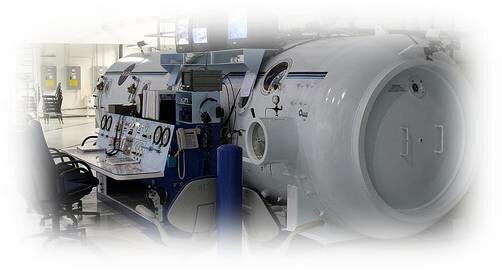
Photo courtesy of E-Mans av8pix.com
The consequences of hyperoxygenation are of a great significance:
- The total oxygenation of body inside hyperbaric chamber now equals to a maximum oxygen-carrying capacity of haemoglobin plus up to 2000% increase of oxygen concentration in plasma and other body fluids
- Plasma saturated with oxygen does not just enhance the oxygen-carrying capacity of haemoglobin. Reaching concentrations of up to 6 mL/dL (at a pressure of 3 atmospheres) oxygen dissolved in plasma exceeds metabolic requirements of tissue and bone cells regardless of haemoglobin supply 223
- Oxygen carried by plasma is capable to reach destinations in oxygen deprived tissues or bones otherwise unavailable to red blood cells carrying haemoglobin molecules
In other words, hyperbaric oxygen can safely by-pass or disregard the "ill" state of what normally serves as the main oxygen delivery transport - the haemoglobin. In healing some acute health conditions such as an exceptionally severe anaemias or carbon monoxide poisoning this property of hyperbaric oxygen plays a crucial role. This outstanding ability of hyperoxygenation constitutes the essence of Hyperbaric Medicine.123, 124, 125
In the hypoxic wounds, hyperoxygenation improves the pathophysiology associated with oxygen deficiency and impaired wound healing. A key factor in hyperbaric oxygen treatment's enhancement of the hypoxic tissues is its ability to establish adequate oxygenation levels within the vascularised connective tissues surrounding hypoxic sites.
The following graph presents an example of a baseline ulcer tissue oxygenation at room air concentration, then after 20 min exposure to 100% oxygen at 1 atmosphere absolute (1 ATA) and finally after 20 min exposure to 100% oxygen at 2 ATA. The ulcer tissue oxygenation was evaluated by transcutaneous O2 pressure (TCpO2) measurements using a pulse oximeter.
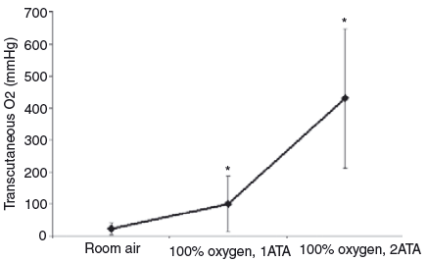
Hyperoxygenation results in an improved leukocytes function when killing bacteria, improved antibiotic effectiveness, and an enhanced collagen synthesis.
Additional positive effects of hyperoxygenation may persist even after the completion of hyperbaric oxygen treatment. Among them are: prevention of leukocyte activation and adhesion following ischaemic reperfusion, blunting of systemic inflammatory responses, inhibition of bacterial toxin synthesis, etc.
Dr. Richard Neubauer
Late Dr. Richard Neubauer, an internationally recognized pioneer in the application of hyperbaric oxygen therapy (HBOT) for a variety of neurologic disorders, became interested in potential applications of HBOT during the early 1970s. Dr. Neubauer's research and clinical practice led to the conclusion that hyperbaric oxygenation can help to restore functions of the damaged neurons of the brain.
Among the conditions researched and treated by Neubauer at his Ocean Hyperbaric Neurologic Center in Lauderdale-by-the-Sea, Florida, USA, have been multiple sclerosis, near drowning, cerebral palsy, traumatic brain injury (TBI), anoxic encephalopathy, coma, and stroke. A special focus has been made to the treatment of severely afflicted children with mitochondrial diseases.
Books of Dr. Richard Neubauer serve a complete guide for caregivers who are considering using hyperbaric oxygenation therapy. Written in a semi-scientific manner, the information is also of a great value to physicians, researchers, and insurance providers seeking accurate and proven insight about the value of hyperbaric oxygenation therapy. Most popular books of Dr. Richard Neubauer:
If you prefer to grasp Hyperbaric Oxygen Therapy (HBOT) by reading a hyperbaric medicine textbook, we recommend a selection of books from Amazon.com. Many of the recommended books are written for the layman, making heavy medical science easy to read. The recommended books include an overview of HBOT, the theory behind it filled with facts and explanations, specific conditions treated, the outcomes of those treatments, case studies and many references. Click here to proceed...




